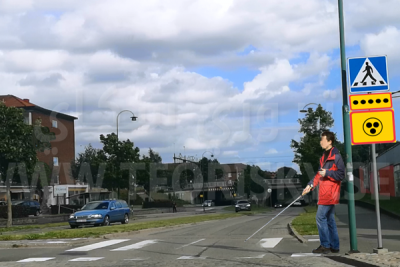When driving a car on the road, you must pay attention to pedestrians, especially the blind and the hearing impaired
You are also obligated to give priority under any circumstances to people with special needs, and you must facilitate their safe passage and not cause them tension or fear.
Special plates alert the driver to the presence of people with poor vision and hearing
Sign 1

The sign means hearing loss
Sign 2

The sign means poor eyesight
Visually and hearing impaired
Blind people always use a white cane when walking and moving on the street

This is so that they can be distinguished and their position taken into account, in addition to the fact that the stick helps in feeling the place or the ground
To determine the direction they want to go.
Hints and signals using a white stick
- When it is straight and directed towards the ground, it means that the person is waiting and listening.
- When the stick is tilted forward, this means that the person wants to walk.
When you see a blind person wanting to cross a pedestrian crosswalk
- Stand at a sufficient and safe distance and let him cross calmly.
- Do not press the accelerator pedal, make engine sounds, or use the horn so as not to startle him.
- Wait a little while after the person crosses so that he does not become frightened or terrified by the sound of the car accelerating.
- Keep the sound of the car quiet and calm so that someone will know that you stopped for him to cross and that you saw him.
Dogs that accompany the blind
- There will be a white circle around the dog’s neck
- It helps the blind person navigate and avoid obstacles on the road
- You should never frighten him or approach him.
Pedestrian crossings
In general, you must give priority to pedestrians of all categories if the crossing is not protected by a traffic light
You should also not exaggerate your reactions. For example, if you see a person standing next to the road, do not stop and ask him to cross
She insists on this and annoys him, because he may not want to cross, but is just standing next to the road
It is not permissible for you to signal someone to cross, either with your hands or by any other means.
The senses and human nature change as one grows older, and older people change in the following things:
- The ability to see well gets worse.
- Hearing ability gets worse and weaker.
- Weakness of the body leads to imbalance.
- Interaction weakens and leads to delayed action.
- Sometimes they get things wrong.
Therefore, when you arrive at a pedestrian crossing and see an elderly person who wants to cross or is crossing, be kind and wait patiently.
